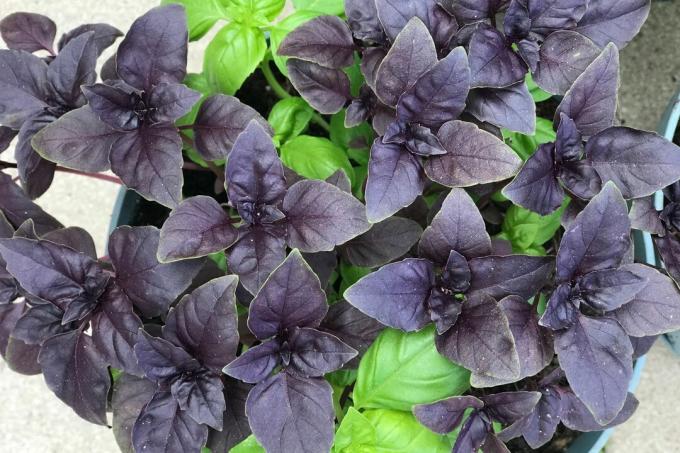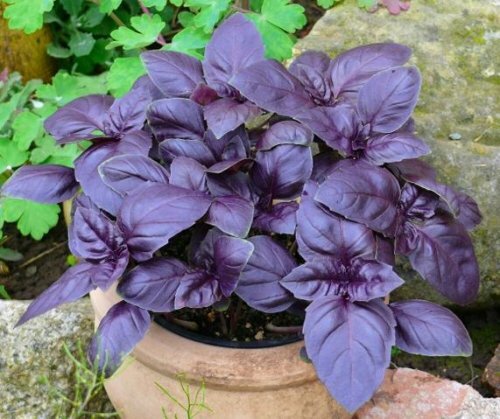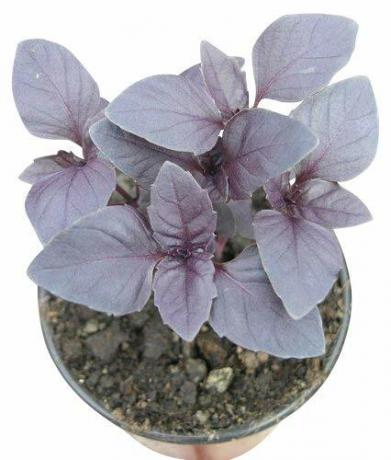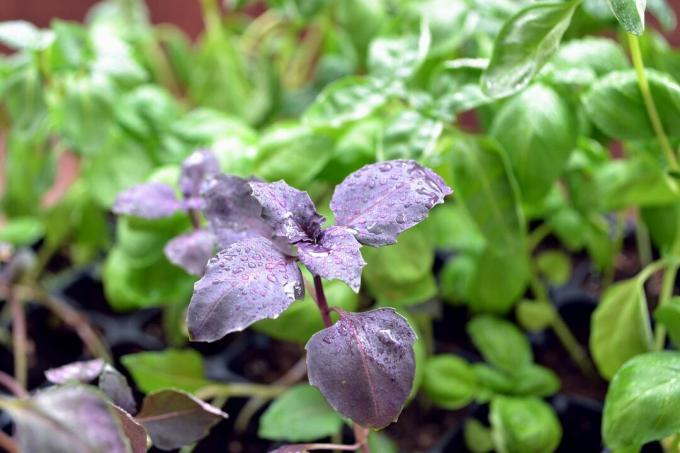In addition to the well-known green-leaved basil, there are also black and red-leaved varieties. We'll show you everything about the variety of basil.

basil (Ocimum basilicum L.) belongs to the lip flower family (Lamiaceae). Most species of this genus thrive in the tropical climates of Asia, Africa, Central and South America. The basil probably comes from India. However, the popular leaf herb has enjoyed great attention for several thousand years in the form of targeted cultivation for cultural purposes and for cooking. In Egyptian pyramids, relics of the basil could be found during excavations. In the Hindu faith, the red-leaved varieties have a traditionally important meaning.
contents
- Grow black basil in your own garden or on the balcony
- Multiplication
- Pour and fertilize the black basil
- Caring for black basil
- Black basil varieties: this is where color comes into play
- Harvest and store black basil
- Black basil: ingredients and uses in cooking
Here in Central Europe, basil has only been known as a cultivated plant since the Middle Ages. In this country it is also called royal herb, derived from the Greek basileus, which means 'king'. But red and dark-leaved varieties are also enjoying increasing popularity. The intense color is caused by the high content of anthocyanin in the cells. We'll show you everything you need to know about this tasty color wonder.
Synonyms: basil, basil, royal herb
Grow black basil in your own garden or on the balcony
Just like its famous big brother, black basil prefers well-drained soil. This should be as sunny as possible so that the dark-leaved ones Basil varieties can develop their striking foliage color vigorously. As long as the temperatures do not drop below 10 ° C, it does not matter whether it is kept in a pot or in a bed. In any case, if the temperature is too low, the basil must always be kept warm to avoid damage from the cold. Basil is usually cultivated as an annual herb, but it can also be brought over the winter in a warm location at a constant temperature of at least 10 ° C. Somewhat more robust varieties are particularly suitable for this.

Multiplication
In order to grow basil in your own garden, on the balcony or on the windowsill, it is advisable to grow the seeds indoors from March. For this purpose, cultivation pots are provided with a suitable substrate (e.g. B. a mixture of earth and sand). Also the Plantura organic herb & seed compost is ideal for the propagation of your basil plants. Since basil is a light germinator, the sowing should not be covered with substrate. However, since this would protect the swelling seeds from drying out, greater care must be taken to ensure that the seeds are adequately supplied with water during the germination process and do not become dry. At a temperature of 18–25 ° C, the basil seeds germinate within 7 to 14 days, depending on the variety. With a seedling size of about 5 cm, the small plants should be pricked out into larger pots. Depending on the size of the pot, several basil plants should be placed together in one pot - for example five to ten plants in a pot with a diameter of 13 cm. Because black basil is sensitive to cold, caution should be exercised when planting it out. Even after the ice saints in mid-May, night temperatures can still fall below the critical level of 10 ° C.
Pour and fertilize the black basil
The same applies to watering and fertilizing the black basil as to its green-leaved relatives. It is very thirsty and hungry. This is why daily watering may also be necessary in the bed on hot, sunny days. Since basil is one of the strong eaters, it should be planted in nutrient-rich, humus-rich soil if possible. The substrate that is used for the culture in the pot must of course have a correspondingly high nutrient content. The planting bed can be wonderfully fertilized by digging under compost or manure in early spring. Pot basilica must be re-fertilized with a complete nutrient fertilizer via the irrigation - weekly during the main growing season. For fertilizing your basil plants, for example, is suitable Plantura organic universal fertilizer ideal. As soon as the basil stops growing in autumn, an additional four to six week supply of nutrients to the potted herbs is sufficient.
In the bed gets along Ocimum excellent with tomatoes, Kohlrabi or Cucumber and drive away the whitefly there. On the other hand, they are bad neighbors Lemon balm or savory.
Caring for black basil
Basil can damage your own garden Snail damage, Aphids or the whitefly occur. The Lucerne mosaic virus causes mosaic-like patterns on the leaves. Herbal viral pathogens are not supposed to be seriously harmful to human health, but it just doesn't look nice. There are now even vague studies that the consumption of virus-infected herbal products can promote migraine and diarrhea symptoms.
Direct contact of the leaves with water promotes infection with fungal diseases. To prevent this, a location that is as protected from rain as possible should be chosen in the garden during the warm season. In addition, it should always be watered in such a way that the leaves of the basil do not get wet. Should the leaf spots caused by the fungal pathogens appear, the affected parts of the plant must be removed and destroyed.
Black basil varieties: this is where color comes into play
For the variety of flavors of the different Basil varieties Essential oils are responsible. Some types smell sweet like aniseed or liquorice, others like lemon or camphor and even cinnamon aromas are represented.

We have put together our favorite varieties for you here:
- opal: Popular variety with cherry-colored, edible flowers and red leaves.
- Red Ruffles: Dark red leaf color and deeply slit leaf margins with pink-purple flowers, which are also edible; the aroma contains notes of anise, cinnamon, some citrus and pepper.
- Red ruby: This black-leaved variety offers a peppery aroma and a slight sharpness. Red Rubin was awarded the “All America Selection Winner” award in 1992, primarily for its visual appeal.
- Genovese basil red: The well-known Genovese basil with red leaves has a high ornamental value, but the same taste as its green counterpart.
- Bush basil Purple Ball: The leaves of this variety are significantly smaller and very spicy. The growth is short and bushy.
- Wild purple: A sturdy variety with intense purple foliage that is well suited for outdoor cultivation.

Basil, dark opal
2,99€
Details →
- 6%

Basil Red Ruby
1,60€1,50€
Details →

Basil * dark opal *
1,49€
Details →
Harvest and store black basil
In the Basil harvest care should be taken not to remove too much of the leaf mass. The plant does not recover from this very well. Whole shoots should be removed, which promotes compact growth. But the shoots must not be cut too deep. Let the lower leaves stand. They are not as aromatic as the younger, higher-up leaves and the plant can also continue to gather strength for the branching sprouting of side buds.
The essential oils of basil evaporate very quickly and the variety of aromas can only be preserved to a limited extent. This is why black basil is best used freshly harvested. Both by drying and freezing the colored aromatic leaves, most of the aromatic oils are lost and the basil tastes like almost nothing. Just like with the green-leaved basil, however, soaking in oil or processing into pesto are very suitable to preserve the aroma of black basil for a few months.
You can find more useful information in our article Harvest and store basil properly.
Black basil: ingredients and uses in cooking
We know basil mainly from Italian cuisine in pasta dishes or classically with Caprese. But it is also often used in Asian cuisine.

In order to preserve as much of the spicy aroma as possible, basil should always be added to the dishes at the end of the cooking process. If basil is cooked, it is quickly overcooked and the flavoring essential oils quickly dissolve in the air.
In addition, the herb is said to have some medicinal properties. For example, basil is said to strengthen the digestive organs and stimulate the appetite. The ingredient eugenol has an anti-inflammatory effect. Methyleugenol, on the other hand - also an ingredient of basil - can be carcinogenic if ingested in high concentrations. That is why basil is not used as a medicinal herb, albeit in an unattainably high number Basil leaves would have to be consumed in order to increase the critical level of methyleugenol by enjoying the spicy leaves exceed.
In any case, the black basil impresses with its high ornamental value. And since the herb can also bring various taste experiences into the kitchen, it deserves a place in every garden or balcony as a colorful exotic.
Also in ours Plantura herb growing kit contains seeds for dark-leaved basil. In the set you will also find everything you need for sowing basil and three other herbs.
